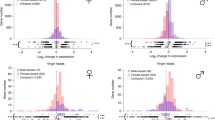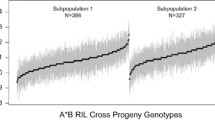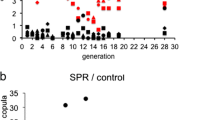Abstract
Mating behavior, including courtship and copulation, is a main component of male fitness, especially in species with no parental care. Variation in this behavior can thus be a target for mate choice and sexual selection, and can lead to evolution. The fruit fly, Drosophila melanogaster, has well-documented complex male courtship comprised of a sequence behaviors, and is an ideal model for behavior-genetic analysis. In order to evaluate genetic differences in the temporal pattern of mating behavior, we developed a high-throughput method that allows us to document the progression of male courtship and copulation using an ordinal scale (male mating progression scale, MMP). Using this method, we document natural genetic variation in the temporal pattern of behavior that was not detected using other metrics. This method was robust enough to detect genetic variation in this trait for males placed with both virgin and mated female targets.


Similar content being viewed by others
References
Andersson MB (1994) Sexual selection. Princeton University Press, Princeton, NJ
Anholt RRH, Mackay TFC (2004) Quantitative genetic analyses of complex behaviours in Drosophila. Nat Rev Genet 5(11):838–849
Aspi J, Hoikkala A (1993) Laboratory and natural heritabilities of male courtship song characters in Drosophila montana and D. littoralis. Heredity 70(4):400–406
Balakireva M, Stocker RF, Gendre N, Ferveur JF (1998) Voila, a new Drosophila courtship variant that affects the nervous system: behavioral, neural, and genetic characterization. J Neurosci 18(11):4335–4343
Bastock M, Manning A (1955) The courtship of Drosophila melanogaster. Behaviour 8:7–110
Beaver LM, Giebultowicz JM (2004) Regulation of copulation duration by period and timeless in Drosophila melanogaster. Curr Biol 14(16):1492–1497
Boake CRB, Konigsberg L (1998) Inheritance of male courtship behavior, aggressive success, and body size in Drosophila silvestris. Evolution 52(5):1487–1492
Bouletreau J (1978) Ovarian activity and reproductive potential in a natural population of Drosophila melanogaster. Oecologia (Berl) 35:319–342
Casares P, Carracedo MC, Miguel ES, Pineiro R, Garciaflorez L (1993) Male mating speed in Drosophila melanogaster – differences in genetic architecture and in relative performance according to female genotype. Behav Genet 23(4):349–358
Connolly K, Cook R (1973) Rejection responses by female Drosophila melanogaster – their ontogeny, causality and effects upon behavior of courting male. Behaviour 44(1–2):142–166
Drapeau MD, Long AD (2000) The Copulatron, a multi-chamber apparatus for observing Drosophila courtship behaviors. Drosoph Inf Serv 83:194–196
Etges WJ (2002) Divergence in mate choice systems: does evolution play by rules? Genetica 116(2–3):151–166
Falconer D, Mackay T (1996) Introduction to quantitative genetics. Longman, Essex, England
Ferveur JF, Jallon JM (1993) nerd, a locus on chromosome-III, affects male reproductive behavior in Drosophila melanogaster. Naturwissenschaften 80(10):474–475
Fujii S, Krishnan P, Hardin P, Amrein H (2007) Nocturnal male sex drive in Drosophila. Curr Biol 17(3):244–251
Gailey DA, Jackson FR, Siegel RW (1984) Conditioning mutations in Drosophila melanogaster affect an experience-dependent behavioral modification in courting males. Genetics 106(4):613–623
Gefen E, Marlon AJ, Gibbs AG (2006) Selection for desiccation resistance in adult Drosophila melanogaster affects larval development and metabolite accumulation. J Exp Biol 209(Pt 17):3293–3300
Gleason JM, Ritchie MG (2004) Do quantitative trait loci (QTL) for a courtship song difference between Drosophila simulans and D. sechellia coincide with candidate genes and intraspecific QTL? Genetics 166(3):1303–1311
Greenspan RJ, Ferveur JF (2000) Courtship in Drosophila. Annu Rev Genet 34:205–232
Gromko MH (1987) Genetic constraint on the evolution of courtship behavior in Drosophila melanogaster. Heredity 58:435–441
Gromko MH, Markow TA (1993) Courtship and remating in field populations of Drosophila. Anim Behav 45(2):253–262
Gromko MH, Briot A, Jensen SC, Fukui HH (1991) Selection on copulation duration in Drosophila melanogaster – predictability of direct response versus unpredictability of correlated response. Evolution 45(1):69–81
Hall JC (1994) The mating of a fly. Science 264(5166):1702–1714
Hoffmann AA (1999) Is the heritability for courtship and mating speed in Drosophila (fruit fly) low? Heredity 82:151–157
Konopka RJ, Kyriacou CP, Hall JC (1996) Mosaic analysis in the Drosophila CNS of circadian and courtship-song rhythms affected by a period clock mutation. J Neurogenet 11(1–2):117–139
Kulathinal RJ, Singh RS (2004) The nature of genetic variation in sex and reproduction-related genes among sibling species of the Drosophila melanogaster complex. Genetica 120(1–3):245–252
Lasbleiz C, Ferveur JF, Everaerts C (2006) Courtship behaviour of Drosophila melanogaster revisited. Anim Behav 72:1001–1012
Littell RC, Stroup WW, Freund RJ (2002) SAS for linear models, 4 edn. SAS Institute Inc, Cary, NC
Mackay TFC, Heinsohn SL, Lyman RF, Moehring AJ, Morgan TJ et al (2005) Genetics and genomics of Drosophila mating behavior. Proc Natl Acad Sci USA 102:6622–6629
Markow TA (2002) Perspective: female remating, operational sex ratio, and the arena of sexual selection in Drosophila species. Evolution 56(9):1725–1734
Markow TA, Hanson SJ (1981) Multivariate analysis of Drosophila courtship. Proc Natl Acad Sci USA 78(1):430–434
Markow TA, Castrezana S, Pfeiler E (2002) Flies across the water: genetic differentiation and reproductive isolation in allopatric desert Drosophila. Evolution 56(3):546–552
Martin P, Bateson P (1993) Measuring behaviour: an introductory guide. Cambridge University Press, Cambridge
Mcrobert SP, Tompkins L (1988) 2 consequences of homosexual courtship performed by Drosophila melanogaster and Drosophila affinis males. Evolution 42(5):1093–1097
Moehring A, Mackay T (2004) The quantitative genetic basis of male mating behavior in Drosophila melanogaster. Genetics 167(3):1249–1263
Partridge L, Hoffmann A, Jones JS (1987) Male size and mating success in Drosophila melanogaster and Drosophila pseudoobscura under field conditions. Anim Behav 35:468–476
Pyle DW, Gromko MH (1981) Genetic basis for repeated mating in Drosophila melanogaster. Am Nat 117(2):133–146
Reif M, Linsenmair KE, Heisenberg M (2002) Evolutionary significance of courtship conditioning in Drosophila melanogaster. Anim Behav 63(Part 1):143–155
Ritchie MG, Gleason JM (1995) Rapid evolution of courtship song pattern in Drosophila willistoni sibling species. J Evol Biol 8(4):463–479
Ritchie MG, Kyriacou CP (1994) Genetic variability of courtship song in a population of Drosophila melanogaster. Anim Behav 48(2):425–434
Ryner LC, Goodwin SF, Castrillon DH, Anand A, Villella A et al (1996) Control of male sexual behavior and sexual orientation in Drosophila by the fruitless gene. Cell 87(6):1079–1089
SAS Institute (2006) SAS Online Documentation v. 9.1. Available: http://support.sas.com/91doc/docMainpage.jsp. Accessed 2006
Sawamura K, Tomaru M (2002) Biology of reproductive isolation in Drosophila: toward a better understanding of speciation. Popul Ecol 44(3):209–219
Service P, Rose M (1985) Genetic covariation among life-history components – the effect of novel environments. Evolution 39(4):943–945
Siegel RW, Hall JC (1979) Conditioned responses in courtship behavior of normal and mutant Drosophila. Proc Natl Acad Sci USA 76(7):3430–3434
Stamenkovicradak M, Partridge L, Andjelkovic M (1992) A genetic correlation between the sexes for mating speed in Drosophila melanogaster. Anim Behav 43(3):389–396
Stevens J (1992) Applied multivariate statistics for the social sciences. Lawrence Erlbaum Associates, Hillsdale, NJ
Stirling DG, Reale D, Roff DA (2002) Selection, structure and the heritability of behaviour. J Evol Biol 15:277–289
Tauber E, Roe H, Costa R, Hennessy JM, Kyriacou CP (2003) Temporal mating isolation driven a behavioral gene in Drosophila. Curr Biol 13(2):140–145
Yamamoto D, Nakano Y (1998) Genes for sexual behavior. Biochem Biophys Res Commun 246(1):1–6
Zar JH (1996) Biostatistical analysis. Prentice Hall, Upper Saddle River, NJ
Acknowledgements
We would like to thank the National Science Foundation (NSF DEB 0296177), University of Illinois Program in Ecology, Evolution, and Conservation and the Francis M. and Harlie M. Clark research grant for financial support for this research. We would also like to thank M. M. Reedy and the members of the Hughes lab for help with the flies, and R. M. Reynolds, J. M. Drnevich, A. L. Toth, A. M. Bell, R. Fuller, H. M. Robertson, A. V. Suarez, G. E. Robinson, and three anonymous reviewers for their useful comments on this manuscript.
Author information
Authors and Affiliations
Corresponding author
Additional information
Edited by Yong-Kyu Kim.
Appendices
Appendices
Rights and permissions
About this article
Cite this article
Ruedi, E.A., Hughes, K.A. Natural Genetic Variation in Complex Mating Behaviors of Male Drosophila melanogaster . Behav Genet 38, 424–436 (2008). https://doi.org/10.1007/s10519-008-9204-5
Received:
Accepted:
Published:
Issue Date:
DOI: https://doi.org/10.1007/s10519-008-9204-5




